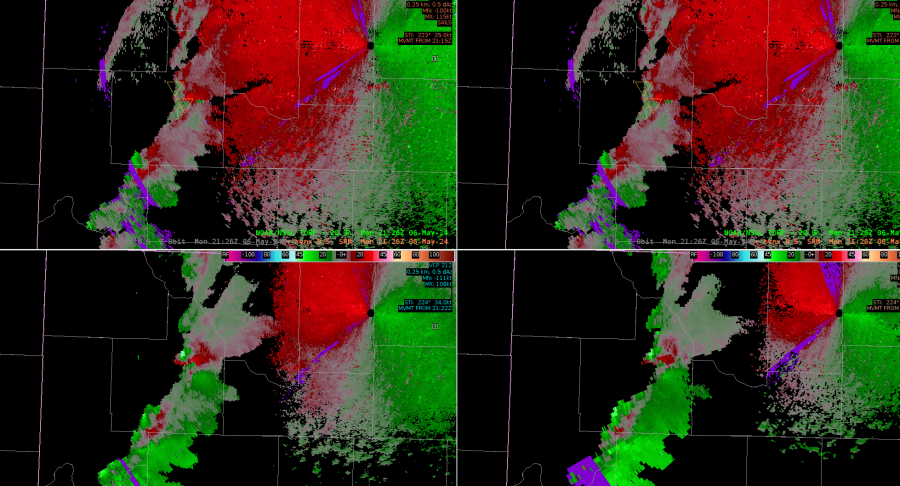Follow up to the last post. Convection has re-oriented to (1) be more favorable for mesovort generation given the shear vector orientation to the UDCZ, and (2) to minimize TORP objects along the leading edge since the beam orientation is more perpendicular. -dryadiabat 
Category: News
Early Thoughts on Tuesday AM Case
Despite a messy linear structure oriented down-radial, AzShear initially proved valuable in highlighting a weak circulation and TORP even highlighted it with ~30% probability. I was pleasantly surprised to see this after witnessing some tracking and object identification issues in quasi-linear structures during the real time event Monday afternoon.

Things went a bit downhill after that. It became apparent that TORP was over-identifying in an area that actually showed convergence in velocity data, but oriented to the radar in a way that it also lit up AzShear (which I suspect is the leading cause). Granted, 


I should note that the above is with no probability threshold set. With a 30% threshold, most of these disappeared, so while it appears TORP may be over-identifying, the probabilities associated with these objects are low and fairly easy to successfully filter out.
– Mr. Peanut
AzShear vs SRM Fields (Bill Lumbergh Post)
Along this line southwest of the radar, AzShear values increased but SRM still looked benign. TORP did pick up on probs above 20% and defined it as an object


TORP increased in area of the line break along with three ingredients method for meso vortex generation, decided to follow CR CWIP guidance and issue SVR w/TOR Possible TAG.
The portion of the line where the updraft/downdraft convergence zone (UDCZ) caused AzShear to jump and looks to be prompting higher TORP probabilities. It will be very critical for warning mets to know this limitation and be able to identify it, similar to vertical sidelobe contamination. These kinds properties may nearly require a RAC like training, even for experienced forecasters.
See photo below, noticing we are getting a lot of TORPs above 20 % when we get a line break with reflectivity, which is one of the CWIP nudgers

After turning on the range filtering in the Phi Tool, noticed an area closed to LWX had a 95% probability within the SVR w/TOR Possible tag. This was also near a line a break. Went ahead and issued a warning. Had I seen this object earlier, I would have considered a tornado warning earlier, but I only noticed it after the Vrot on SRM drastically increased. But these probs seem to matching some of the 3 IMs as stated in Schaumann and Pryzblylinzky (2012). (See two photos blelow)


Az_Shear appears to be catching on to increasing V_rot about 1-2 scans prior to when I as a forecaster catch onto it. This would certainly be useful to notice a trend is happening before it becomes apparently visible to the eye via SRM. (see below)
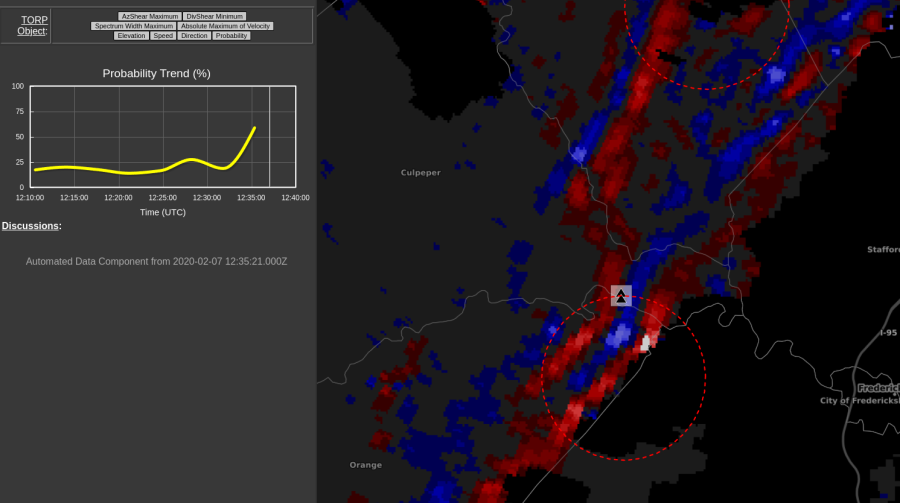
Object 88 near Myersville around 1244z, not sure why it would be there (below)

“Don’t time match on reflectivity”.
As of 1252z, coming up with better ideas for D2D procedure bundles and perspective to integrate AzShear/DivShear into a smoother work flow. I will have to compare MRMS rotational track, as well as MRMS 0-2km Azmithal Shear. These products may be able to replace a lot of MRMS product used for velocity fields. However, MRMS will still be needed for hail.
The workload of looking at AzShear and DivShear has decreased the amount of time am looking at Dual Polarization products. However, this could be in part because of only having one AWIPS screen, where at the office I would have 3. And perhaps having GR2 opened in on a Windows PC could also change this for easier viewing of Dual Pol products. Will need to make a consciously effort to incorporate Dual Pol with these products into my workflow.
Another example of TOPR going up with line break. Also, it appears that we get a “couplet”, or a “dipole” like feature in DivShear where enhanced convergence is next to divergence (see 2 pictures below)


TORP probabilities of 30-50% (especially is showing an increasing trend) get my attention on radar and has me exploring base products more (and I need to be better about dual pol). TOPR above 70% has pushed me issue a tornado warning. Even in times of false alarm, I still get a problematic Vrot that I would likely issue a warning on ~1-2 scans later. TORP trends appears to be helping to add some lead time, especially if probs start crossing above 50%. Here on Day 2 of the experiment, still trying to mentally calibrate AzShear/DivShear values with this TORP output.
Shear Along the Leading Edge of Convection
Noticing low probabilities from where the radial is parallel to the leading edge of the convection. -dryadiabat 
Monday Real Time

Some low probability false alarms associated with ground clutter near radar.

No TORP showing up for fairly strong rotation.
Finding myself issuing tornado warnings around 40% TORP compared to 50% for practice case earlier this afternoon. Possibly due to a better feel for the environment in mind. However, this was not true for all storms, especially those further away from radar where personal confidence was lower.

Example of side lobe contamination possibly impacting TORP.

It would be nice if the future trend portion of the graph was shaded differently to make it stand out better at quick glance.

Showing similar DivShear values/highlighting, though only one area is highlighted by the TORP. Therefore, divshear may not be very useful for low TORP values.
Discontinuous Probability Trend
I noticed about a 10 minute break where probabilities briefly dropped off, and the probability trend data reset. I know this is based on 0.5 degree velocity data, but the midlevel mesocyclone has been persistent across the entire time period. -dryadiabat
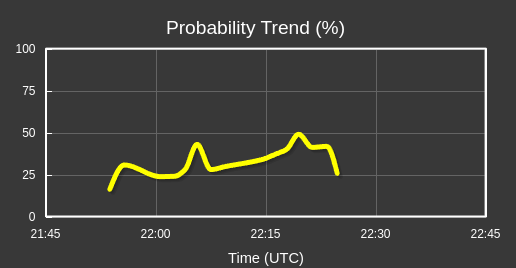

I really love the probability trends. Very helpful, because the legacy method is manual Vrot calculation and remembering scan to scan. This provides a much clearer picture of important trends. This is the Major County storm. -dryadiabat
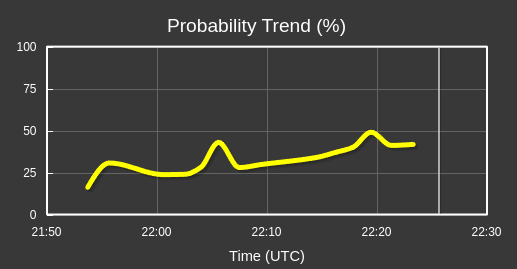
TORP Values Still Modest
TORP values have been modest so far. Environment is favorable but higher LCL values than expected in the next hour or so, when the environment becomes very favorable for tornadoes as hodographs begin to elongate and discrete supercells move into richer low level moisture.


TORP Detections

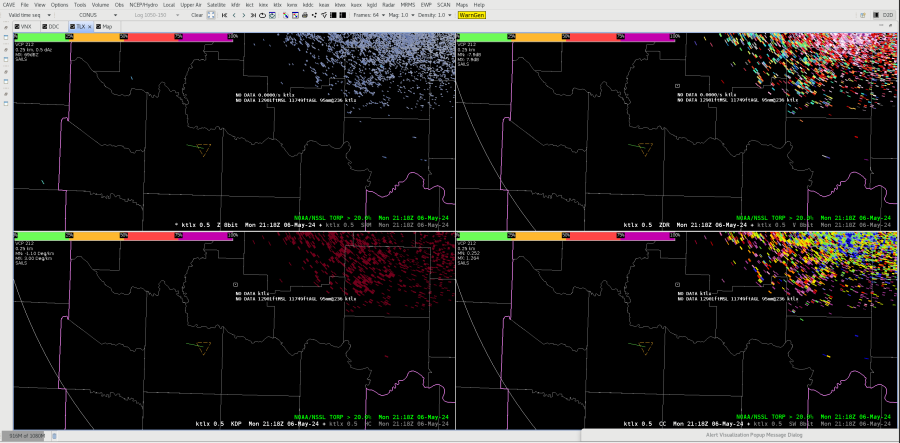
On two instances, noticed false detections where there was no activity. Still showing low probabilities overall.
-FujitaReno
TORP Responding as Deep Mesocyclone Strengthens
TORP is responding to deepening/strengthening midlevel mesocyclone with increasing probabilities. -dryadiabat
